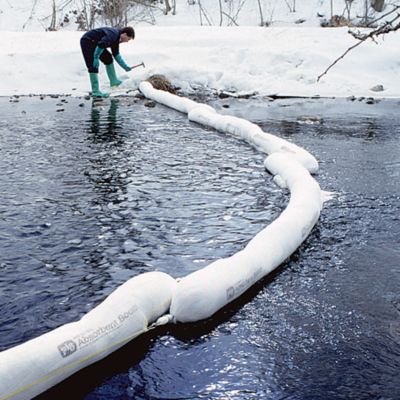Socks do a great job of absorbing machine leaks and containing smaller spills, but what happens when you’ve got a really big spill — or you need to cl

Absorbent booms come in a variety of diameters and lengths to contain and soak up big oil-based spills on land and water. Here’s how to choose the best boom for your application.
The Long and Short of It
Most absorbent booms come in 3 and 6 meter lengths. How you deploy the boom will help you determine the length you need. For a spill response team, 3-meter booms are easier to handle — especially when they’re saturated and heavy.
When you’re dealing with large spills on water, 6-meter booms are easier to deploy from a boat. As each boom is lowered into the water, it will be clipped to the next section. Longer booms mean fewer connections.
Size Matters
Those big booms look impressive surrounding an overturned petrol truck in the news footage, but in most cases, they’re overkill. There are a couple of points to consider before you choose a 8, 13 or 20 cm diameter boom:
How much do you need to absorb?
Check the absorbency of different diameter booms and choose the one that best matches the spill you need to protect against. You may estimate needing enough boom to absorb 900 litres on a paved surface, but if you plan to do that over 150 meters of boom, you can save a lot of money and still get the absorbency you need by purchasing 8 or 13 cm diameter booms.
Where will you use the booms?
Water conditions are a factor in choosing the diameter of a boom. As a general rule:
- 8 cm booms are best for ponds, lakes or small creeks and land-based spills
- 13 cm booms are for creeks and areas with slow moving water
- 20 cm booms are for more turbulent waters and moving water up to 1 knot
Regular vs Spaghetti
Spaghetti booms are made to clean up heavy, viscous oils on water. The filler consists of long strips of polypropylene that provide more surface area to trap these oils and allow them to be absorbed into the boom. Because the filler strips in these booms reduce diking efficiency on land, spaghetti booms should only be used on water.
Regular Oil-Only booms are usually filled with polypropylene fibre that absorbs refined petroleum-based liquids and vegetable oils without taking on any water. They have good diking capacity and can be used on land and water.
White vs Brown
White booms are typically used for spill response. Their bright colour helps responders quickly identify their location. And, unless the oil product being absorbed is clear, it is easy to tell when the boom has become saturated.
Brown booms are commonly used in retention ponds and other areas where they are being deployed for longer periods of time as a protective measure. The brown colour helps them blend into their surroundings.
New Pig’s Service Advisors are available from 8:30 a.m. to 5:00 p.m. Monday to Friday to help you select a suitable Boom or other product to meet your needs. Give us a call at 0800 919 900 or e-mail us at pigpen@newpig.com.






COMMENTS